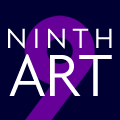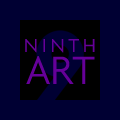>> Top Nine: O'Brien's Choice
>> Article 10: Arts From Their Elbows
More...

In my previous column, we looked at how, despite aiming to be the number three publisher by now, CrossGen is actually lagging down there at number five. So this seems a good time to look at the actual number three - namely Image.
Of course, Image is not the publisher it once was. Back in the early nineties, Image was the publisher riding the zeitgeist. Mind you, in retrospect, "the publisher who defined the early to mid nineties" is not a title anyone would necessarily want.
A publisher as relentlessly fashionable as early Image could never continue in quite that form; it was either going to wither when the fashions changed, or evolve a new role for itself. What eventually happened was a bit of both. Todd McFarlane and Marc Silvestri have kept to a scaled down version of what's worked in the past; Jim Valentino has changed Image Central beyond recognition; and Erik Larsen seems to focus on his creator role.
Image remains number three, but we're clearly back to having a big two. The August charts, typically enough, have Marvel and DC splitting two thirds of the direct market between them. Image heads up the stragglers, with a 7.53% dollar share (marginally more if you go by unit share). That places it ahead of Dark Horse on 5.78%, but not by a resoundingly huge margin. CrossGen is normally in the same region as well; its disastrous showing on the August chart reflects its current reduced shipping schedule.
'A publisher as fashionable as early Image could never continue in that form.' It feels as if we've had three different phases of Image as a publisher. The first phase, when it bestrode the industry like a colossus. The second phase, where the partners began to disintegrate, while Jim Valentino embarked on a total reinvention of the Image Central line. And phase three, where it's just kind of there. Image is sort of like Dark Horse, in that it's hard to imagine the industry without it, but the big show has moved on.
The Image of 2003 is a thoroughly schizophrenic publisher. That seems an inevitable result of the business's quasi-partnership structure, where the four remaining partners - Valentino, Silvestri, McFarlane and Larsen - almost seem to operate independent businesses that happen to share a corporate umbrella. For any of them to go independent would mean a swift banishing to the back pages of Previews, so they remain together as a curious marriage.
Valentino wants to provide a platform for the small press and upcoming creators, and a venue for creator-owned work. McFarlane is ploughing on as always. Larsen focuses his efforts on his beloved SAVAGE DRAGON and doesn't seem all that interested in the publishing side of things. And Top Cow sulks at the back of the Image section in Previews, not really wanting to join in the party.
Image had nine books in August's top 100 in August. Four of them were SPAWN #127, POWERS #33, MAGDALANE #3 and WITCHBLADE #67. The other five were GI JOE #20-21, and GI JOE FRONTLINE #11-13. But unfortunately for Image, the GI Joe books really belong to Devil's Due, which is going its own way shortly. (If you're wondering about the graphic novels chart, by the way, Image had one book listed - a LIBERTY MEADOWS hardback at number 36.)
It shouldn't surprise anyone that Image isn't raking in the audience figures the way it used to. Image Central has steered in a determinedly uncommercial direction, at least by direct market standards. Given the typical interests of the direct market audience, it would be surprising if books like HAWAIIAN DICK were doing all that well; it would be an absolute miracle for, say, AGE OF BRONZE to achieve direct market success. One can only imagine that the aim of publishing books like this is to get them into the trade paperback bookstore market, where - at least going by the conventional wisdom - they ought to have a rather better chance. It might also be noted that the standard Image Central deal is a flat fee plus 25% of trade paperback sales; consequently, creators stand to make more money from books whose sales skew towards the TPB format.
'Image remains number three, but we're back to having a big two.' Then again, Image's recent attempts to get back into superhero comics didn't work out all that well. The books in the superhero line debuted low and only crashed from there. DOMINION was already in black and white, for budgetary reasons, by issue #2. Some of the other books were actually all right - FIREBREATHER and INVINCIBLE had a certain charm to them - but nobody was interested. DC and Marvel seem to have that part of the industry sewn up. And on any view, the sales of books like Steve Uy's FEATHER (debuting at number 184) aren't exactly spectacular. Even with minimal publicity, his Marvel book EDEN'S TRAIL sold more copies with its first issue.
When small press and self-published creators started to sign up for Image, one argument for doing so was that they would get the benefit of the Image brand name. People who otherwise wouldn't try these comics would be drawn in by the mystical letter I. This sounded somewhat plausible at the time, but if it was ever the case, it doesn't work any more. The line is just too diverse for that. Image is not a publisher with some particular creative direction, where a regular Image reader might reasonably assume that a new Image comic is likely to be along the lines that he's enjoyed in the past. The idea of an Image zombie is about as ludicrous as the idea of a Harper Collins zombie. Of course, that's a reflection of one of Image's great strengths - its diversity - but it does beg the question of whether the Image name still serves much function other than as something to call the company. What, if anything, does it mean as a brand?
Recently, it's been licensed properties like GI Joe that have been producing most of Image's hits. But a lot of those have been the products of studios like Devil's Due, publishing via Image Central. And there's been a very noticeable trend of late for these production studios to break from Image, clearly feeling they can do better elsewhere. The latest to pack up and leave is Roaring Studios, who are publishing their next book through Devil's Due.
'The idea of an Image zombie is as ludicrous as the idea of a Harper Collins zombie.' In the discussion thread which follows this Newsarama report, Roaring's Mike Miller explains why he's so unhappy with Image Central. Much of what he says seems to be general irritation over communication breakdowns. He also misses the mark with some of his complaints; he can scarcely complain that Image didn't promote HEDGE KNIGHT better when that was never its responsibility in the first place, for example.
But his underlying point is clear. Because Image only provides a basic publication service, the Image flat fee just doesn't represent good value for money. Also, in the case of the studios, Image's concern for its own brand conflicts with the studios' desire to promote themselves. But in any event, Image just isn't doing enough to merit the fee.
This will vary from book to book, of course. Roaring's HEDGE KNIGHT #1 appeared to be a fairly high-budget affair; the same financial considerations won't necessarily apply to JACK STAFF or PARADIGM. The incompatibility of studios with the Image Central set-up may simply be a matter of shoving a round peg in a square hole; Image Central has always struck me as being intended for individual creators, not as a mechanism for entire studios to exist within Image. If that's the sort of book that Image is interested in publishing then it really needs a different model to deal with it.
For individuals, the Image model has clear advantages over its obvious competitors (other small publishers and self-publishing). There's less work involved than self-publishing. And you do get that high profile listing in Previews, which at least tends to draw some reviews and attention to the book - although turning that attention into actual sales seems to be another matter. For high-profile creators who can be sure of decent sales, like Brian Bendis, the Image Central set-up has obvious appeal; ditto for creators who are working with a fairly low budget to start with. Likewise, new creators who have money to burn can at least rely on increasing their standing in the industry by publishing through Image, which should make for more opportunities down the road.
Maybe this is the best deal Image is in a position to offer; and it undoubtedly has its advantages, not least creator ownership. Still, it is a deal with limits; and if it's the model Image is planning around for the future, then it's not going to be returning to the Big Three any time soon. But then, in terms of the quality of its output, it's light years ahead of where it was in its Big Three days; Image has found a role, and despite its drawbacks, it's still a role worth having.

This article is Ideological Freeware. The author grants permission for its reproduction and redistribution by private individuals on condition that the author and source of the article are clearly shown, no charge is made, and the whole article is reproduced intact, including this notice.


